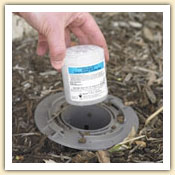Advance Bait Systems
To Bait or Not To Bait? That is the Question.
Baits are an important tool for termite prevention and control programs. Conventional termite treatments for existing homes rely primarily on soil-applied liquid termiticides. However, there are a number of situations where a baiting system may be preferred over a liquid treatment, used along with a liquid treatment, or it may be one of the few alternatives to a liquid treatment. For example:
- There is a foundation drain around the house.
- There is a natural water source near by like a well, stream, pond, or lake.
- A proper treatment would require extensive drilling of a slab that is covered by a wooden, tiled or carpeted floor, or drilling through other masonry such as a finished basement wall.
Which is the best method of termite control?
Because liquid treatments and bait treatments are used (and work) very differently, it is difficult to compare the two methods in terms of which one works “better”. The  current soil-applied liquid termiticides act essentially as chemical barriers to stop invading termites and kill the ones that are actively infesting the structure. Termites encounter these treated barriers during the course of their normal underground foraging activities. With the baiting systems, termites obviously must find and eat the bait in order for the chemical to be effective. It is important to realize that the bait stations and their contents generally do not “attract” termites. Just as with baits used for cockroaches, ants, and rodents, the termite bait stations contain materials that the manufacturers have determined to be attractive food sources for the termites. Studies have shown that some of these materials appear to be “preferred” or more attractive than the surrounding wood (Your Home). Termites find the stations during their normal foraging activities, just as they might find any other underground
current soil-applied liquid termiticides act essentially as chemical barriers to stop invading termites and kill the ones that are actively infesting the structure. Termites encounter these treated barriers during the course of their normal underground foraging activities. With the baiting systems, termites obviously must find and eat the bait in order for the chemical to be effective. It is important to realize that the bait stations and their contents generally do not “attract” termites. Just as with baits used for cockroaches, ants, and rodents, the termite bait stations contain materials that the manufacturers have determined to be attractive food sources for the termites. Studies have shown that some of these materials appear to be “preferred” or more attractive than the surrounding wood (Your Home). Termites find the stations during their normal foraging activities, just as they might find any other underground  food source. There is no way to predict how soon termites will find and feed in a bait station so an important part of the baiting strategy is to install the stations completely around the structure. For that reason, a thorough inspection of the house and immediate property is important before the stations are installed. Once the bait system is installed, the impact is not immediate. By design, the baits contain chemicals that may take several days, weeks, or even months to kill individual termites depending upon the age of the termite and the type of chemical in the bait. This delayed effect is important. You want the termites to carry the bait back to the colony and feed it to other termites within the nest. As a result, it may take several months before the entire colony is substantially reduced and eliminated. Baiting is a long term approach to termite control.
food source. There is no way to predict how soon termites will find and feed in a bait station so an important part of the baiting strategy is to install the stations completely around the structure. For that reason, a thorough inspection of the house and immediate property is important before the stations are installed. Once the bait system is installed, the impact is not immediate. By design, the baits contain chemicals that may take several days, weeks, or even months to kill individual termites depending upon the age of the termite and the type of chemical in the bait. This delayed effect is important. You want the termites to carry the bait back to the colony and feed it to other termites within the nest. As a result, it may take several months before the entire colony is substantially reduced and eliminated. Baiting is a long term approach to termite control.
The baiting program continues year-round. The key to a successful termite baiting program is proper monitoring and maintenance of the stations. Inspections will be made on a monthly or quarterly basis. One of our professional technicians will keep you informed during the entire process.
With The SurGuard Advantage termites will never have a chance.